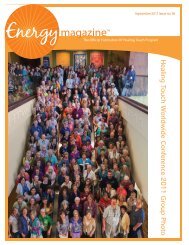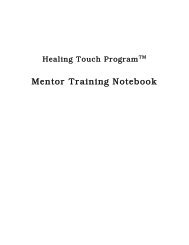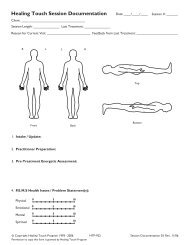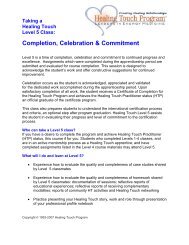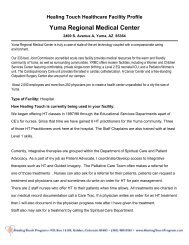Quantum Science for Energy Healers: A Practical Guide Workbook ...
Quantum Science for Energy Healers: A Practical Guide Workbook ...
Quantum Science for Energy Healers: A Practical Guide Workbook ...
You also want an ePaper? Increase the reach of your titles
YUMPU automatically turns print PDFs into web optimized ePapers that Google loves.
<strong>Quantum</strong> <strong>Science</strong> <strong>for</strong> <strong>Energy</strong> <strong>Healers</strong>: A <strong>Practical</strong> <strong>Guide</strong> <br />
Topic M: Review of Week 2 <br />
<strong>Workbook</strong> : Week 3 Answer Key <br />
©2010 <br />
<br />
M:1 Week 2 began by comparing the causal view of Western philosophy with the <br />
holistic view of Eastern traditions. This was developed within the context that many <br />
phenomena observed in sub‐atomic physics could not be explained from a causal <br />
framework. The Buddhist “empty circle” was then used as a metaphor <strong>for</strong> <br />
discussing holism. Holism thus gives us a more useful context <strong>for</strong> understanding the <br />
integration of wave‐particle duality, uncertainty, periodicity and quantized energy <br />
used by Schrodinger to develop the modern quantum model of the atom. The atom <br />
and hence matter becomes an energetic probability distribution <strong>for</strong> electrons which <br />
can be anywhere, at any instant, about the nucleus. Moreover, each moving electron <br />
creates waves of quantized electromagnetic radiation there<strong>for</strong>e, matter is not solid, <br />
rather it is dense, highly structured energy. In the final section, the compression <br />
waves of sound energy were studied, as well as, their ability to give <strong>for</strong>m and <br />
structure to the energy fields of matter. <br />
Topic N: What is a laser? <br />
N:1 Key words: <br />
Laser: is a device which can produce a very narrow intense beam of <br />
monochromatic coherent light <br />
Coherent light: alignment of the crests and troughs between 2 or more <br />
waves of light. <br />
N:2 Question to Ponder: <br />
N:2.1 What are the advantages of coherent light over incoherent light? <br />
The coherent light <strong>for</strong>ms an extremely narrow beam of a specific frequency <br />
of light which is very intense and can be used to destroy tissue, cauterize and <br />
/or weld tissue or weld/ machine metals. None of this can be accomplished <br />
with ordinary light as it too diffuse. <br />
Topic O: How do holograms work? <br />
O:1. Key Words <br />
Virtual image: An image which is <strong>for</strong>med by our brain when it interprets any <br />
light coming towards our eyes in a straight line. A virtual image, however, will not <br />
appear on a piece of paper or film when it is placed at the location of the image.
<br />
O:2. Questions to Ponder <br />
O:2.1.Describe what it is like to view a hologram: <br />
The image appears as a 3D object and you can walk around it and observe the <br />
image shift as you change your orientation. If you put your hand out to touch it, it <br />
will only pass through the image. <br />
O:2.2. In what manner do holograms support the idea of holism that we <br />
discussed in week 2? <br />
Every point in the hologram contains light from the original scene and hence <br />
the entire image can be viewed from 1 small piece. There<strong>for</strong>e, each piece contains <br />
the “whole” image and the “whole “ image is made up of all the pieces. <br />
Topic P: How do our sense organs work? <br />
P:1 Key words <br />
Neurotransmitter: A chemical found in vesicles (sacs) in the synaptic area of <br />
nerve cells. This chemical is released when an electrical impulse is transmitted <br />
through the nerve. The chemical crosses a small space to stimulate the adjoining <br />
cell or “deliver the message” so to speak. <br />
P:2 Question to Ponder <br />
P:2.1 Outline some of the factors which might affect our abilities to observe <br />
an event, and our individual perceptions of what occurred. <br />
There is a huge cascade of messages from the occurrence of a stimulus to the <br />
interpretation by the brain. Some examples include 1) the capacity of the sense <br />
organs to receive and or transmit in<strong>for</strong>mation 2) the capability of the brain to <br />
decode and interpret the in<strong>for</strong>mation 3) the pre‐existing mind/body/spiritual state <br />
of the person 4) the decisions made by the person 5) the previous experience of the <br />
person with the event which took place. <br />
Topic Q: How does our brain work? <br />
Q:1 Key words <br />
Beta: 13‐40 Hz, task oriented, “secretary” mind….prolonged states lead to <br />
anxiety , stress, worry <br />
Alpha: 8‐13 Hz relaxed, joyful, floating, ef<strong>for</strong>tless <br />
Theta: 4‐7 Hz drowsy state, stages 1 & 2 of sleep <br />
Delta: 0‐4 Hz deep sleep, stages 3 & 4 of sleep
EEG: Electroencephalogram— a measurement of the electrical activity of <br />
the brain <br />
Q:2 Questions to Ponder <br />
Q:2.1 Describe some to the evidence which correlates brain wave activity <br />
with mental state <br />
Individual who experience insomnia have a characteristic brain wave pattern <br />
of theta and delta waves while those who have “mind chatter” have a predominant <br />
beta wave pattern. Theta waves are also associated with scar tissue and tumors in <br />
the brain and senility is characterized by a theta/beta brain wave mixture. <br />
Q:2.2Explain the benefits of meditation and how this is supported by brain <br />
wave activity. <br />
Advanced meditators exhibit a characteristic alpha brain wave pattern which <br />
is also associated with a calm, peaceful and joyful presence. Mystics exhibit a <br />
specific alpha/theta pattern. <br />
Topic R: How are energy and matter interrelated? <br />
R:1 Key words <br />
Peptides: small chains of amino acids which act as messengers <strong>for</strong> the endocrine <br />
system <br />
R:2 Question to Ponder <br />
R:2.1Outline how energetic in<strong>for</strong>mation may be processed by the body: <br />
In<strong>for</strong>mation may be received through the crown chakra and stimulate the <br />
pineal gland, which releases specific peptides to stimulate the pituitary gland. This <br />
gland then sends out hormones to regulate the organs of the endocrine system <br />
<br />
Topic S: What is intuition? <br />
S:1 Key Words: <br />
Akashic records: A library or hall of records in a non‐physical plane of existence <br />
which can be accessed by mystics and contains all that is known past, present and <br />
future. From the Sanskrit word meaning “sky”, “space” or “ether” <br />
Higher sense perception: receiving in<strong>for</strong>mation beyond our normal range of senses. <br />
This is often referred to as a 6 th sense but can use any of our modalities or a <br />
combination thereof <strong>for</strong> receiving in<strong>for</strong>mation. <br />
<br />
S:2 Question to Ponder <br />
S:2.1Outline why tuning into our intuition or higher self is most likely a <br />
quantum process. <br />
For many intuitive people, the in<strong>for</strong>mation they receive appears to be a <br />
“vision”, “voice”, “thought”, or “feeling”, however it is not in the normal range of <br />
sensory perceptions and seems to come from “elsewhere” If we consider that we <br />
are energetic beings of a specific vibration or quantum level, then it becomes <br />
plausible that we may have some capacity to tap into a higher quantum level and <br />
receive in<strong>for</strong>mation or that in<strong>for</strong>mation may be sent down to us by dropping its <br />
quantum level. <br />
<br />
<br />




